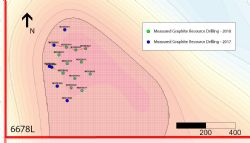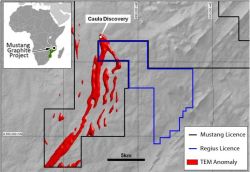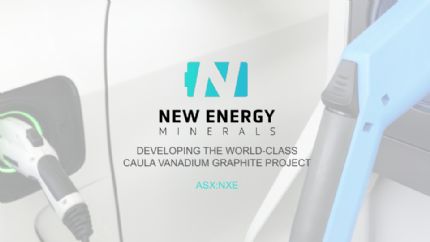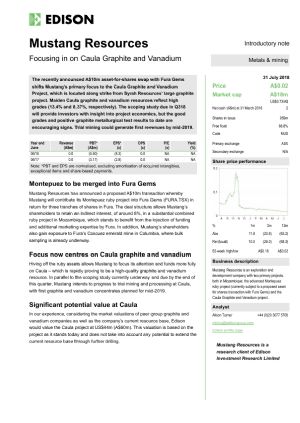Updated Measured Graphite Mineral Resource of 21.9 Mt at 13.4% TGC (8% cut-off)
 Caula Project - Graphite Mineral Resource Increases 317%
Caula Project - Graphite Mineral Resource Increases 317%
Sydney, July 24, 2018 AEST (ABN Newswire) - Mustang Resources Ltd ( ASX:MUS) (
ASX:MUS) ( GGY:FRA) (
GGY:FRA) ( MTTGF:OTCMKTS) is pleased to announce that its Caula Vanadium-Graphite project in Mozambique has taken another key step towards development with the completion of an upgraded JORC-compliant Graphite Mineral Resource estimate.
MTTGF:OTCMKTS) is pleased to announce that its Caula Vanadium-Graphite project in Mozambique has taken another key step towards development with the completion of an upgraded JORC-compliant Graphite Mineral Resource estimate.
Key Points
- Total Updated JORC (Measured) Resource of 21.9 Mt @ 13.4% TGC (8% cut-off) at the Caula Vanadium-Graphite Project in Mozambique
- 317% increase in size of Mineral Resource from 702,600 tonnes to 2,933,100 tonnes of contained Graphite
- The entire Graphite Resource now in the Measured Resource category and upgraded from the initial December 2017 Inferred Resource
- Caula Graphite Resource is subdivided into two zones:
o Oxidised Zone - 8.5 Mt @ 13.4% TGC for 1,130,000 tonnes contained Graphite (8% grade cut-off)
o Fresh Zone - 13.4 Mt @ 13.5% TGC for 1,803,100 tonnes of contained Grapite (8% grade cut-off)
- Substantial scope for further growth in the Graphite Resource through exploration
- Metalurgical testwork confirms exceptional quality graphite with more than 63% of cumulative proportion in large to super jumbo flakes sizes (>180Micronsm) and excellent concentrate grades of more than 97% TGC
- Caula's modified and improved flowsheet design allows for integrated vanadium and graphite extraction
- Following the merger of Mustang's ruby project with Fura, Mustang ideally positioned to become a leading vanadium and graphite company
The Mineral Resource, which is all in the Measured category, is 21.9Mt at 13.4% Total Graphitic Carbon ("TGC") (8% cut-off) for a total of 2,933,100 tonnes of contained Graphite. The Mineral Resource is an update from the previous Inferred Graphite Resource of 5Mt at 13% TGC for 702,600 of contained Graphite1 based upon the completion of eleven additional cored boreholes during November and December 2017. The upgraded Mineral Resource represents a 317% increase in the size of the Mineral Resource from 702,600 tonnes of contained graphite to 2,933,100 tonnes of contained graphite.
Mustang Managing Director Dr. Bernard Olivier said: "This is an exceptional result, Caula's Graphite Mineral Resource has not only increased over 300% but the entire resource is now in the Measured Category. The combination of the upgraded Graphite Mineral Resource and our recently announced maiden Vanadium Mineral Resource now paves the way for the fast-tracked development of the Caula project into production."
Geology of the Caula Graphite Deposit
The Caula deposit is located in northern Mozambique in the Cabo Delgado Province. The graphite mineralisation is hosted in quartzitic schists of the Xixano Complex. The most common lithologies include Graphitic Schists, Gneisses and thin Pegmatoidal zones. Sulphides are occasionally logged but are usually absent. The surrounding country rock consists of Quarzitic and Micaceous Schists and Gneisses.
The project area is situated in the Mozambique Belt of the East African Orogen, and contains highly metamorphosed meta-sediments and meta-volcanics. The rocks of the East-African Orogen are dated 850 - 620 Ma in which metamorphic facies vary from amphibolitic to granulitic.
The mineralised zone is contained within a reclined isoclinal fold structure which dips at roughly 60 degrees to the west (Error! Reference source not found.). Due to the region's tectonic history these meta-sediments have been altered to the extent that no sedimentary structure remains.
Drilling, Sampling and Sub-sampling Techniques
The drilling program comprised of one RC (reverse circulation) and 16 DD (Diamond Drilling) boreholes. The initial part of the hole was drilled with PQ (III) until the rock was competent to be drilled with HQ (III). Drill core was orientated wherever possible. The mineralised core was sampled as half (Leco analysis) and quarter (metallurgical test work) core, with the remaining quarter retained in the stratigraphic sequence in the core trays. Appropriate QA/QC samples (standards, blanks, duplicates and umpire samples) are inserted into the sequence as per industry standard.
Sample Analysis
Sample preparation and analysis was completed by SGS in Johannesburg. Sampling procedure which includes drying, crushing, splitting and pulverising ensures that 85% of the sample is 75 micron or less in size. A split of the sample is analysed using a LECO analyser to determine total carbon in graphite (TGC%) content. A second split of the sample is prepared for element analysis by XRF to determine V2O5 content. Rougher and multiple re-grind and cleaner flotation, Final concentrate PSD and fraction assays was also done.
Resource Estimation Methodology
The geological models used for the resource estimation was created in Voxler (Version 4.2.584), a modelling package developed and distributed by Golden Software in Colorado. The deposit was divided into an upper oxidised zone and a lower fresh zone. Once a specific grade volume has been calculated a weighted average density is applied to the volume and a tonnage is determined.
Weighted averaging for sample length was applied. No grade truncations were applied. A cut-off grade of 8% has been applied. Grade-tonnage curves were produced and can be used to determine the effect of cut-off grades on remaining mineralised tonnages, but the drilled resource is calculated as intersected in-situ. The calculated grade is weighted for representative mass, as calculated in Voxler.
Cut-off Parameters
An 8% TGC grade cut-off was applied. The modelling is limited by drilling extent. The drilling has not intersected nor delineated the outer edge of barren host rock. The physical limits of the mineralisation will be established with additional future drilling.
Grade-tonnage curves were produced (see Figures 2 and 3 in link below) and the influence of various cut-off grades can be investigated. The physical deposit boundaries have not been intersected in the drilling work to date and hence the model is suspended within graphite and roscoelite mineralised rock. The western and northern deposit boundary (at shallow depth), is expected to be delineated with the next phase of drilling. The eastern and southern boundaries are open to at least 200m and several kilometres respectively.
Caula Graphite Resource Estimate
The Caula Mineral Resource estimate is based on 16 diamond drillholes totalling 2,233.21 metres (484.72m in 2016 and 1,748.49m in 2017) and one reverse circulation (RC) drillhole totalling 99 metres (see Figure 4 in link below). Drillholes are spaced approximately 85 metres apart along a 540 metre strike length. With the exception of drillhole MORC004 (-77deg), all holes were drilled at inclinations of between 55deg and 60deg from the horizontal.
The drillhole samples were submitted to SGS in Randfontein (South Africa) for analyses as well as to SGS (Malaga), Independent Metallurgical Operations Pty Ltd ("IMO") and Nagrom, Perth for metallurgical testwork. In total, 1,128 assay results were generated and these were used with the drillhole data to complete the updated Graphite Mineral Resource estimate.
Grade estimation was completed using an inverse distance squared method. The deposit was divided into an upper oxidised zone and a lower fresh zone. Points of equal grade within the model boundary are draped with a wireframe shape (of which the anisotropy settings are defined in the gridder module) and the volume for the shape is calculated in Voxler. This is repeated for grades of 0.01% TGC to 24% TGC for the oxidised zone and up to 26% TGC for the fresh zone.
Once a specific grade volume interval had been calculated (by difference) a weighted average density was applied to the volume and a tonnage determined.
The Measured Mineral Resource totals 21.9 million tonnes at an average grade of 13.4% TGC for 2,993,100 tonnes of contained Graphite.
The results of the Mineral Resource estimate are summarised in Tabel 1, below. Drillhole information and reporting in accordance with the JORC Code 2012 Edition are included as Appendices to this announcement.
The grade-tonnage curve for the oxidised zone is shown in Figure 2 below (see link below). The Oxidised Zone displays the following grade-tonnage relationship: at a cut-off grade of 2% TGC the deposit will have as a balance 13.4 Mt of mineralised tonnes at an average grade of 10.4% TGC, for 1,390,900 tonnes of contained graphite. At a cut-off grade of 4% TGC the deposit will have as a balance 12.0 Mt of mineralised tonnes at an average grade of 11.2% TGC, for 1,350,100 tonnes of contained graphite. At a cut-off grade of 8% TGC the deposit will have a balance of 8.5 Mt of mineralised tonnes at an average grade of 13.4%, for 1,130,000 tonnes of contained Graphite in the Oxidised Zone.
The grade-tonnage curve for the Fresh Zone is shown in Figure 3 below (see link below). For the Fresh Zone the following relationship is seen from the grade-tonnage curve; At a cut-off grade of 2% TGC the deposit will have a balance of 20.5 Mt mineralised tonnes at an average grade of 10.6% TGC, for 2,180,600 tonnes of contained TGC. At a cut-off grade of 4% TGC the deposit will have a balance of 18.6 Mt mineralised tonnes at an average grade of 11.4% TGC, for 2,121,400 tonnes of contained Graphite. At a cut-off grade of 8% TGC the deposit will have a balance of 13.4 Mt mineralised tonnes at an average grade of 13.5%, for 1,803,100 tonnes of contained TGC in the Fresh Zone.
Mineral Resource Classification Criteria
The resource is classified as Measured. The core losses in the DD boreholes were assigned 0% TGC values as a conservative measure. With additional drilling in the future, the confidence in the estimate may very well improve. The Competent Person has no reason to doubt the input data from the core logging to the laboratory results. The estimate is conservative and probably understated in both tonnage and grade.
The surface area of 12.2 Ha is covered by 17 regularly spaced boreholes for an average grid of just less than 85m squared.
In addition, the geovariance which was calculated over 14 ranges with 27 data-pairs shows a sill distance of 170m. This calculation is based on information from 17 boreholes, and may well change as it gets updated with new drilling information. Based on this geovariance, the drill spacing at an average of 85m is considered to be sufficient to determine a measured resource.
Mining and Metallurgical Methods and Parameters
The resource estimation has assumed that the deposit could potentially be mined using open cut mining techniques. No assumptions have been made for mining dilution or mining widths, however mineralisation is generally broad.
On 25 June 2018 Mustang announced the results of additional metalurigcal testwork on the Caula Graphite - Vanadium project. The testwork was conducted on composites from borehole 15 which is centrally located in the measured resource area. The testwork flowsheet was a modification of a similar flowsheet used for the earlier work. The graphite concentrate recovery procedure comprised an initial coarse grind, a de-slime stage (by-passed on Fresh), then rougher flotation followed by three re-grind & cleaner flotation stages and two final cleaner flotation stages. By graphite industry standards, this is a remarkably simple flowsheet.
The cumulative proportion of large to super jumbo flakes (>180?m) comprises 60% of the Oxide Zone while the cumulative proportion of large to super jumbo flakes (>180?m) comprises 68% of the Fresh Zone. The high concentrate grades of more than 97% Total Graphitic Carbon have been maintained in the modified flowsheet.
The flowsheet has been extended to allow integrated extraction of both graphite and vanadium. The first vanadium concentration work is currently in progress and results are expected in due course.
Project Area Potential
The Caula Project is located within a world-class graphite province and there is significant potential to expand this Graphite Resource estimate through ongoing exploration and drilling.
In the immediate vicinity of the Caula discovery, graphite mineralisation has now been defined over a 540m strike length. This mineralisation is up to 230m wide (estimated true thickness) and the depth is completely open-ended at the limit of the current drilling.
A new program of diamond and reverse circulation drilling has been planned to test for both up-dip and down-dip extensions to the Caula deposit in this area.
In addition to the potential to define additional graphite and vanadium mineralisation immediately adjacent to the Caula discovery, there is also very strong potential to define high grade graphite mineralisation over the much larger project area.
The Caula discovery is located at the northern end of a suite of large-scale geophysical (TEM) anomalies that extend over an 18km strike length within Mustang's tenements (see Figure 5 in link below). Drilling at the Caula site confirms a strong spatial correlation between the TEM anomaly and high grade graphite drill hole intersections. The larger-scale TEM anomaly has received minimal drilling to date and therefore remains largely untested.
Mustang proposes systematically to drill test the large-scale TEM target through progressive step out drilling from the Caula discovery. This drilling has commenced.
The Company is highly encouraged by the results received to date from its updated Graphite Resource Estimate and the Caula deposit as a whole. The combination of high grade drilling results, positive metallurgical testwork, a large Graphite Measured Resource estimate, large-scale untested exploration targets and the project's location within a demonstrated world-class vanadium-graphite province confirm the project's potential to create significant future value for the Company.
As previously reported, due to unexpected delays in receiving the final vanadium and graphite assay results from the independent laboratory, the completion of the maiden vanadium resource estimate as well as this graphite resource update was delayed. This delay means that the estimated completion of the Scoping Study has been updated to Q3 2018.
To view tables and figures, please visit:
http://abnnewswire.net/lnk/6568NELQ
About New Energy Minerals Ltd
 New Energy Minerals Ltd (ASX:NXE) (FRA:GGY) is an ASX listed junior mining company, that recently announced the divestment of the Company's Caula vanadium - graphite project and the Montepuez Ruby project in Mozambique.
New Energy Minerals Ltd (ASX:NXE) (FRA:GGY) is an ASX listed junior mining company, that recently announced the divestment of the Company's Caula vanadium - graphite project and the Montepuez Ruby project in Mozambique.

![abnnewswire.com]()
Related Companies
Social Media
Share this Article

 ASX:MUS) (
ASX:MUS) ( GGY:FRA) (
GGY:FRA) ( MTTGF:OTCMKTS) is pleased to announce that its Caula Vanadium-Graphite project in Mozambique has taken another key step towards development with the completion of an upgraded JORC-compliant Graphite Mineral Resource estimate.
MTTGF:OTCMKTS) is pleased to announce that its Caula Vanadium-Graphite project in Mozambique has taken another key step towards development with the completion of an upgraded JORC-compliant Graphite Mineral Resource estimate.  New Energy Minerals Ltd (ASX:NXE) (FRA:GGY) is an ASX listed junior mining company, that recently announced the divestment of the Company's Caula vanadium - graphite project and the Montepuez Ruby project in Mozambique.
New Energy Minerals Ltd (ASX:NXE) (FRA:GGY) is an ASX listed junior mining company, that recently announced the divestment of the Company's Caula vanadium - graphite project and the Montepuez Ruby project in Mozambique.










